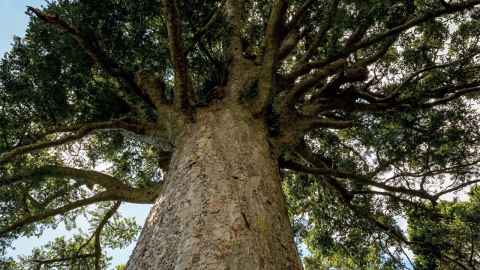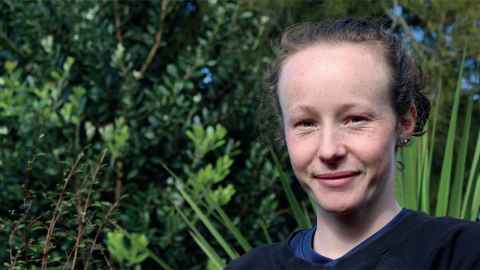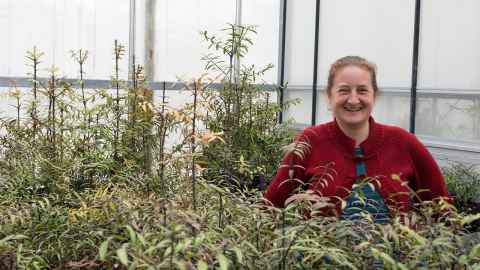Christmas Appeal 2021 - Kauri Dieback Research
You can empower the next generation of researchers.

Help stop a tragedy in its tracks
Kauri dieback disease is caused by a microscopic, soil-borne pathogen called Phytophthora agathidicida (PA), which is related to the golden-brown algae.
Since the first reported case of the disease on Great Barrier Island, the PA organism has been found as the cause of disease in the North Island, infecting regions in the North Island from the Coromandel Peninsular in the South, right up to the Waipoua Forest and beyond in the far north. This forest is home to the majestic, 1,250-year-old Tāne Mahuta – the nation’s most iconic kauri.
Although certain treatments such as phosphite have been used on infected trees to slow the spread of disease, there is currently no known cure.
With more and more trees being infected each year, we urgently need to increase our understanding of this disease, so that we can advance towards developing effective treatments and management strategies that will stop this tragedy in its tracks.
Researching from the roots

Researchers at the University of Auckland are embarking on a vital programme of research that promises to shed new light on the PA pathogen, and develop a chemical treatment that will cure this terrible disease.
Shannon Hunter, PhD student at the University of Auckland’s School of Environment, is just one of the talented researchers involved in this programme. Her PhD project, which is philanthropically funded by the George Mason Centre for the Natural Environment, aims to improve kauri dieback control methods in two stages of research.
Your generosity is not only providing an amazing opportunity for a student like me, but the benefits extend out further in society, through the knowledge generated by research.
Investigating the basic biology of the PA pathogen
Shannon’s research aims to build on this knowledge by characterising the phytophthora community in kauri ecosystems, through environmental DNA analysis of soil samples. As an experienced scientist, Shannon is making a contribution towards the understanding of the pathogen's ecology, vital for the effective management of kauri dieback in the future.
Investigating the effectiveness of treatments in a controlled environment
In the second stage of the project, researchers will investigate the effectiveness of different treatment tools such as phosphite on kauri seedlings. This trial would involve inoculating seedlings with preestablished and novel treatments, to observe the seedlings’ response and improve efficacy.
In addition to analysing the trees’ immediate responses, the team hopes to quantify how effective individual treatments wear off over time, which will inform how these treatments can be built into different disease management scenarios.
“There are really complex issues within forests... One of the challenges is actually assessing the different treatments so that we understand what works where, and how best to apply different treatments and basically to give land managers options,” says Dr Nari Williams, Shannon’s supervisor.
Kauri dieback is an incredibly complex issue. To truly address the challenges of this aggressive disease, it is crucial to invest in talented investigators like Shannon – whose fresh ideas and determination are bringing hope for the future of our forests.
Q&A: Nuturing the next generation of problem solvers

Dr Nari Williams is the Theme Leader for Forest Health within the George Mason Centre for the Natural Environment, at the University of Auckland. Here, she shares her vision for the wider research project, which is underpinned by the talents of passionate young researchers.
Dr Williams, can you talk us through the lines of research the University of Auckland is pursuing to reduce the spread of kauri dieback?
We’ve been developing projects that directly address the management needs for kauri dieback. We’re looking to get several PhD students up and running in this space, and Shannon is the first. We’re looking at various treatment options, and how to get those treatment options into a management framework – implementing it in the field in an environmentally, socially and culturally sensitive manner. And of course, how we track those treatments over time.
What other lines of research will students like Shannon be undertaking?
So we’ll be looking at things like quantifying the efficacy of chemical treatments over time, to determine when a treatment is wearing off. We’re assessing different treatments to understand how best to apply them in different scenarios. We’re also conducting a large-scale surveillance programme, in collaboration with field ecologists, to find out exactly how much of the forest is directly impacted. This will identify areas where we can assess solutions aimed at either preventing the introduction and spread of the pathogen, or improving forest health in already impacted areas.
It’s incredibly important to foster these graduates. Regardless of where their career goes, we need a whole tier of skills and passion behind the protection of kauri.
What makes student scientists like Shannon so vital to this research?
Shannon challenges me and makes me think. She keeps me on my toes, which is refreshing. We need diversity in a research programme, and a flow of new ideas. There are many facets to kauri dieback, and we need more young people coming into this area who really delve into a deeper understanding of the complexity of these issues.
What are the challenges in finding the right students for this programme?
It’s difficult to find students coming through who connect the dots between our environmental ideals and what we can actually do about it. Students ideally need a deep and holistic understanding of the ecology and biology of the complex forest system they are working with. It’s not just about understanding the pathogen, but the way it interacts with its tree host, the complex ecology of the soil, the broader environment and how the management measures imposed will impact these.
By supporting students like Shannon to undertake these studies, what impact will the donors be making on this programme?
We urgently need to put more funding towards our PhD students, to allow them to accelerate key parts of their projects and make a bigger impact with their work – additional experiments for example. It will enable these students to do some exciting research within their PhDs, and not only will that accelerate the work, but also give the next generation of scientists a bigger foundation to build their careers on.